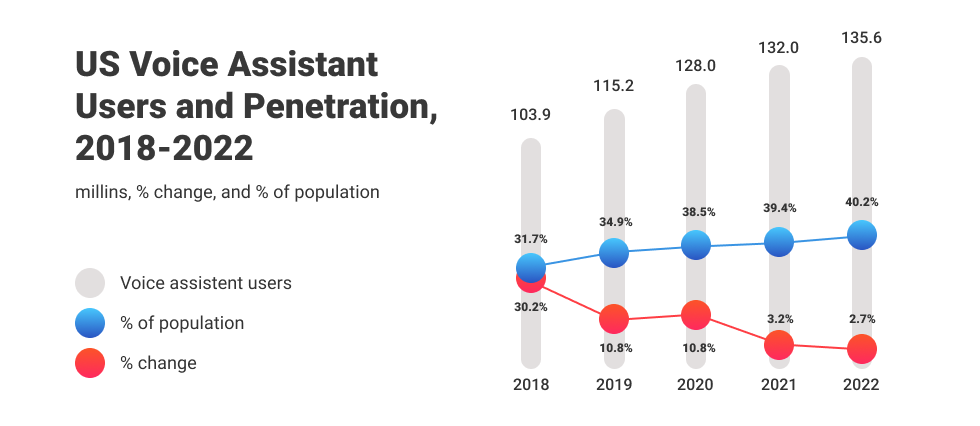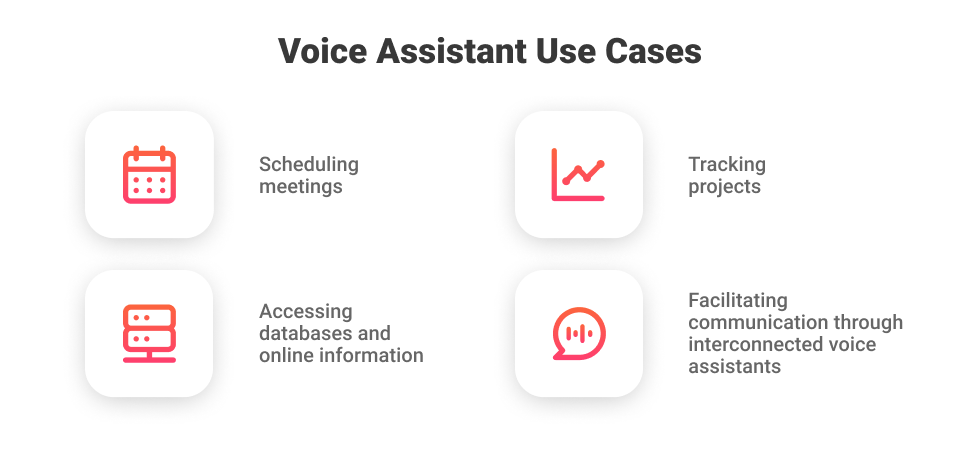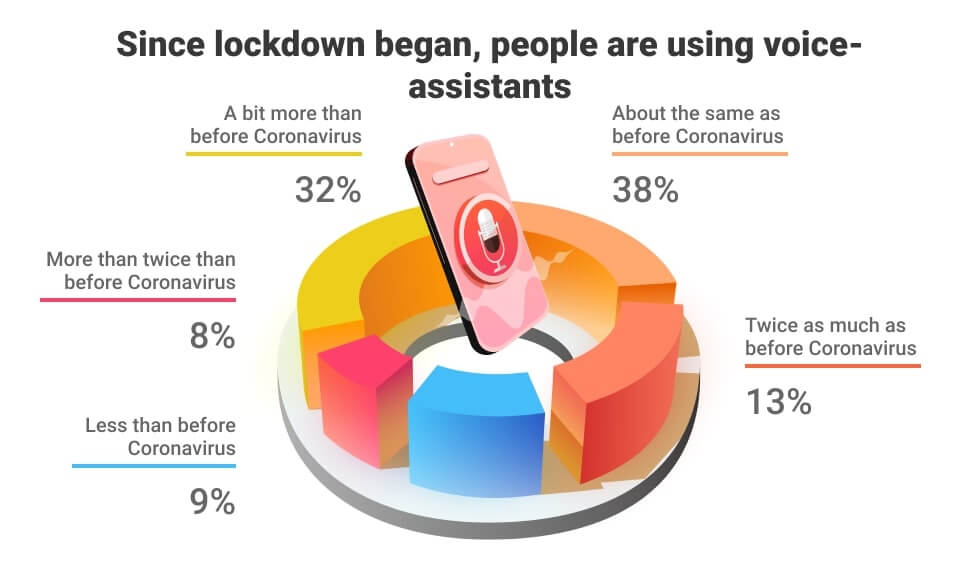The use of voice assistants has been on a rise over the last few years. According to a recent eMarketer report, 38.5% of the US population used a voice assistant in 2020 – that is almost 120+ million users in a year and an increase of 6 million from the previous year.

The report also predicted stable growth for 2021 at a growth rate of 3.2% – bringing the total users to 132 million or 39.4% of the US population.
The rapid adoption of Conversational AI and voice assistant technology leads us to an important question: why should businesses incorporate voice technology in their service offering and how can they achieve a successful implementation? This article explores the answer to that question and more.
Table of Contents
Exploring the Potential of Voice Technology for Enterprise-Level Usage
Potentially, there are 4 major ways enterprises can leverage voice assistants to add more value to the customer experience:
1. Voice Assistants Can Lead to Lack of Socializing
According to Juniper Research’s prediction, users of digital voice assistants may reach 8 billion in 2023.

After all, integrating these voice assistants for customer service could be helpful in 3 different ways:
- Provide customer support 24/7 with AI-based voice assistants.
- Bypass the language barrier using automatic translation mechanisms.
- Automate repetitive steps to save customer’s time.
2. Voice Shopping at Home
According to Invesp – sales through voice shopping may reach $40 Billion in the US by 2022.People prefer voice shopping because:
- Voice shopping collects data from your device and personalizes your shopping experience
- The use of such technology is as easy as speaking
- Quicker than the normal process of surfing through websites for buying a product
3. Reducing Human Workload & Making All Processes Faster
In any enterprise, customer service is often a hectic and exhausting job. Customers can’t always be happy and thus customer-facing jobs are among some of the jobs with the highest turnover rate. To fix this, companies are actively replacing employees with AI-powered conversational bots, both text-based and voice-based chatbots.The reduced workforce requirements for customer service also result in significant cost savings for the business.
4. Using Voice Assistants Within the Enterprise
Deploying voice assistants within the enterprise as a means to improve productivity and as a stepping stone towards advanced automation is becoming increasingly popular. These enterprise-ready voice assistants use machine learning for custom scenarios and a wide range of jobs. In addition, Machine Learning allows these voice agents to analyze usage patterns and personal preferences for a more human-like experience.
In essence, the more employees use an AI voice assistant, the better it gets. Some of the popular use cases for voice assistants within an enterprise include:
- Scheduling meetings
- Tracking projects
- Accessing databases and online information
- Facilitating communication through interconnected voice assistants
Key Challenges of Implementing Voice Assistants For Enterprises
Deploying any form of technology comes with challenges and pitfalls. Thankfully, in the case of voice assistants, the majority of pitfalls can be avoided by simply understanding them and planning in advance (and in some cases, by managing expectations).

Following are four such challenges that companies should account for to ensure a successful deployment of voice assistants:
1. Difficulty in Understanding Certain Voice Types
According to Techcrunch, the understanding and reliability of voice assistants toward children is quite erratic. A squeaky voice, smaller vocal folds, and mispronunciation of words due to an underdeveloped larynx all play a role in reducing the effectiveness of voice assistants.Unfortunately, children aren’t the only demographic that voice assistants are less effective with. A recent report suggested that Google Assistant isn’t equally effective with all races and genders. This is a result of a lack of racial and gender diversity in machine learning (ML) of Google’s voice models. In essence, because Google mostly uses the voice of a white male to train Google Assistant’s ML engine, it faces trouble understanding different accents and languages.
Amazon, Apple, IBM, and Microsoft also face similar challenges but thankfully, this issue has been acknowledged by all tech giants leading the AI voice development and the accuracy rate for speech recognition is increasing every day.
2. Background Noises & Voice Quality
The voice interface devices (VID) used in personal settings such as one’s home are different from ones used in an enterprise. The background noise at an average home is in the range of 40 to 60 db, which means voice assistants require powerful noise-canceling algorithms to provide accurate responses.
A poor voice assistant without proper noise cancellation and voice enhancement can’t suppress so much disturbance and will most likely not be able to process everyday requests.Thankfully, this issue, should it arise, can be resolved with a software patch from your AI voice assistant vendor remotely.
3. A Threat to Privacy & Security Concerns
Recently, McDonalds was sued for collecting their customer voiceprints with its new AI-powered automated drive-thru windows. As per reports, the AI-powered voice assistant did not take any permission to collect customer voiceprints. This led to a violation of the Illinois Biometric Information Privacy Act (BIPA).
And with governments imposing stricter regulations and compliance frameworks, privacy and security are becoming a greater concern with new technologies such as AI voice assistants. However, vendors have been anticipating such regulations and greater security and privacy has been a top priority for every company.
4. Voice Assistants Can Lead to Lack of Socializing
When a groundbreaking technology starts evolving and going viral, it’s a human tendency to use it. Such is the case with voice assistants. The problem here is that voice assistant may, in certain cases, begin to cannibalize other marketing and sales channels such as in-store purchases. For many companies, in-store shopping is crucial for maintaining customer loyalty. To avoid this, voice assistants are beginning to offer a greater level of personalization in order to improve customer loyalty.
Similarly, a lack of socializing within an enterprise is a concern for many C-suite executives. However, voice assistants will not be completely replacing in-person communication any time soon.
5. Deploying within a legacy architecture
Legacy architectures are still very common in enterprise-level organizations. Due to the size of their IT systems, quickly migrating to the cloud to deploy voice assistants isn’t an option. Instead, legacy businesses must either develop integration modules that make cloud-based assistants compatible with their on-prem hardware, software, and processes.
Businesses can either develop these modules in-house or outsource development to external partners – the latter being the more popular option. more challenge.
How Has COVID-19 Impacted the Use of Voice Technology at Enterprise-Level?
The COVID-19 pandemic was a truly black-swan event that had an impact on nearly every industry, the AI voice assistants industry being no exception.

According to Voicebot.ai, 90 million people in the US used smart speakers in 2020. These 90 million people account for 35% of the total population of the US.
The study compares 2020 growth figures with previous years and finds that the number of smart speaker users has been increasing every year since 2017 (and very likely even before that). However, what stands out is the rate of growth per year.

While smart speaker usage in the US increased by 42% between 2017-2018 and another 32% between 2018-2019, it only grew by 1.8% in 2020. The growth rate did not drop so drastically because it reached a saturation point – we’re far from that. One of the biggest reasons for this drop was COVID-19. Everything from global quarantines to limited shipping/supply chain operations played a role in handicapping the growth of smart speakers.
On the other hand, the COVID-19 pandemic has been a catalyst for boosting the use of conversational AI in certain industries including the health sector. Since 2020, the telehealth (remote health care) sector saw a growth of 5% as AI voice assistants played a key role in providing essential healthcare to a world that had no medical workers to spare.
The Future of Voice Assistants in the Enterprises
Despite a long history and a user base in the millions, voice assistant technology is just getting started. In fact, we’ve only scratched the surface of what’s possible and with continued R&D and investment, voice assistants are offering a more personalized and human-like experience every day.
For instance, at Master of Code, we’ve embraced human-centric Conversation Design to build more effective conversational agents (both text-based and voice-based). The compound learning ability of these voice assistants, made possible by the latest in natural-language-understanding (NLU), makes them extremely versatile and nearly indistinguishable from their human counterparts in numerous business applications.
But the future of voice AI will not be limited within an enterprise. As we’ve already seen, voice assistants are playing a key role in managing this global health crisis – helping screen and triage patients, walking patients through CDC COVID-19 assessments, and recommending next steps through telehealth apps.
Similarly, the automobile industry, especially the likes of Tesla, Ford, and Mercedes Benz, has been showing a keen interest in AI voice assistants in recent years. Capgemini Research Institute says 95% of the people who own cars worldwide will be using voice assistants in the next 3 to 4 years. In essence, touch screens replaced buttons in cars and as AI voice technology became a bigger part of our daily lives, voice assistants will replace those touch screens in the coming decade.
Wrapping up…Where Are We Heading?
According to Markets and Markets, the conventional AI industry is expected to grow from $4.8 billion in 2020 to $13.9 billion by 2026.

As a result, the pressure to integrate speech recognition systems into their IT systems and consumer-facing applications quickly is growing. However, these systems lack the human-centric behavior that customers have come to expect from modern voice assistants.
On the other hand, the Ai-based voice assistants offer open architecture platforms, a myriad of integration solutions, and advanced machine learning capabilities that make them far more capable of delivering that important human touch to the customer experience.
But developing and deploying your own conversational AI solutions comes with its own challenges. Fortunately, most of them can be overcome with the right Conversational AI company.
Let us help you connect your brand with customers where they communicate today. Chat or voice.







